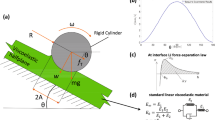Abstract
Charles-Augustin de Coulomb postulated that the act of rubbing of surfaces against each other leads the asperities on the surfaces to deform and mount each other. Thus, in order for tangential motion to ensue, an associated lift-up in the direction normal to the surface, will take place. Although this behavior has been sporadically pointed out in literature, we believe that the butterfly curves associated with it during presliding have not been reported before. We have performed dry, presliding rubbing experiments that show that there is a regular, relative normal displacement associated with the tangential motion; in particular, that normal motion describes rate-independent, hysteresis, butterfly curves (similar in nature to those found in piezo-electric and magnetic materials), in the tangential displacement and in the tangential force, respectively. This communication outlines and explores the basic behavior of those butterfly curves experimentally.















Similar content being viewed by others
References
Amontons, G.: On the resistance originating in machines. In: Proceedings of the French Royal Academy of Sciences, pp. 206–222 (1699)
Dowson, D.: History of Tribology. Longman, London (1979)
Bowden, F.P., Tabor, D.: The Friction and Lubrication of Solids. Clarendon Press, Oxford (1950)
Johnson, K.L., Kendall, K., Roberts, A.D.: Surface Energy and the Contact of Elastic Solids. Proc. R. Soc. Lond. Math. Phys. Sci. 324, 301–313 (1970)
Derjaguin, B.V., Muller, V.M., Toporov, Y.V.: Effect of contact deformations on the adhesion of particles. J. Colloid Interf. Sci. 53(2), 314–326 (1975)
Maugis, D.: Adhesion of spheres: the JKR-DMT transition using a Dugdale model. J. Colloid Interf. Sci. 150(1), 243–269 (1992)
Tolstoi, D.M.: Significance of the normal degree of freedom and the natural normal vibrations in contact friction. Wear 10(3), 199–213 (1967)
Gitis, N.V., Volpe, L.: Nature of static friction time dependence. J. Phys. D: Appl. Phys. 25(4), 605–612 (1992)
Oden, J.T., Martins, J.A.C.: Models and computational methods for dynamic friction phenomena. Comput. Methods Appl. Mech. Eng. 52(1–3), 528–634 (1985)
Al-Bender, F., Lampaert, V., Swevers, J.: A novel generic model at asperity level for dry friction force dynamics. Tribol. Lett. 16(1), 81–93 (2004)
De Moerlooze, K., Al-Bender, F., Van Brussel, H.: A generalised asperity-based friction model. Tribol. Lett. 40(1), 113–130 (2010)
Wang, Z., Suryavanshi, A.P., Yu, M.-F.: Ferroelectric and piezoelectric behaviors of individual single crystalline BaTiO3 nanowire under direct axial electric biasing. Appl. Phys. Lett. 89, 1–3 (2006)
Li, F.-X., Li, S., Fang, D.-N.: Domain switching in ferroelectric single crystal/ceramics under electromagnetic loading. Mater. Sci. Eng. B 120, 119–124 (2005)
Pietzsch, O., Kubetzka, A., Mode, M., Wiesendanger, R.: Observation of magnetic hysteresis ant the nanometer scale by spin-polarized scanning tunneling spectroscopy. Science 292, 2053–2056 (2001)
Bienkowski, A., Kaczkowski, Z.: Major and minor magnetorestriction hysteresis loops on Co–Ci–Ni ferrite. J. Magn. Magn. Mater. 215(216), 234–236 (2000)
Zivkovic, I., Drobac, D., Prester, M.: Two component butterfly hysteresis in RuSr2EuCeCu2O10. Physica C 433, 234–239 (2006)
Sojoudi, H., Khonsari, M.M.: On the modeling of quasi-steady and unsteady dynamic friction in sliding lubricated line contact. ASME J. Tribol. 132(1), 012101 (2010)
Lampaert, V., Al-Bender, F., Swevers, J.: Experimental characterisation of dry friction at low velocities on a developed tribometer setup for macroscopic measurements. Tribol. Lett. 16(1–2), 95–105 (2004)
Tomlinson, G.A.: A molecular theory of friction. Philos. Mag. 7(7), 905–939 (1929)
Iwan, W.D.: A distributed-element model for hysteresis and its steady-state dynamic response. J. Appl. Mech. 33(4), 893–900 (1966)
Al-Bender, F., Lampaert, V., Swevers, J.: Modeling of dry sliding friction dynamics: from heuristic models to physically motivated models and back. Chaos 14(2), 446–460 (2004)
Al-Bender, F., Lampaert, V., Swevers, J.: The generalized maxwell-slip model: a novel model for friction simulation and compensation. IEEE Trans. Autom. Control 50(11), 1883–1887 (2005)
Acknowledgment
This research is partially sponsored by the Fund for Scientific Research—Flanders (F.W.O.) under Grant FWO4283. The scientific responsibility is assumed by its authors.
Author information
Authors and Affiliations
Corresponding author
Rights and permissions
About this article
Cite this article
Al-Bender, F., De Moerlooze, K. & Vanherck, P. Lift-up Hysteresis Butterflies in Friction. Tribol Lett 46, 23–31 (2012). https://doi.org/10.1007/s11249-012-9914-y
Received:
Accepted:
Published:
Issue Date:
DOI: https://doi.org/10.1007/s11249-012-9914-y




